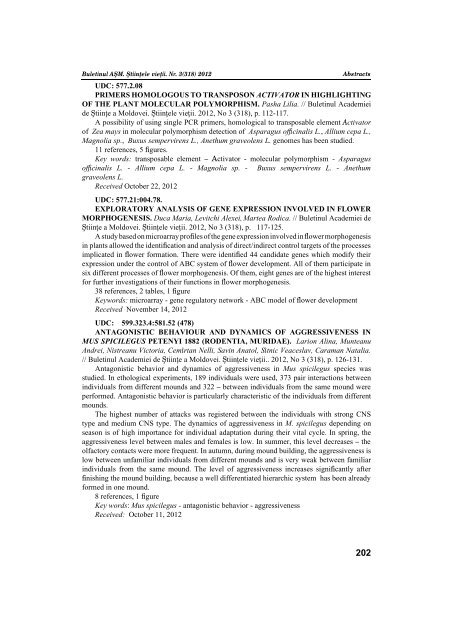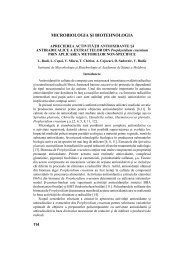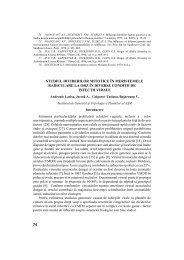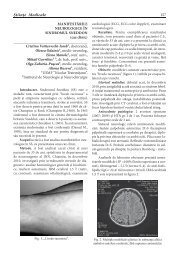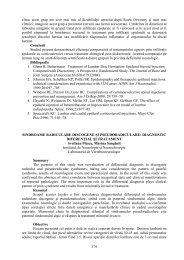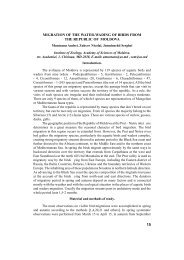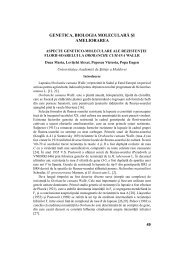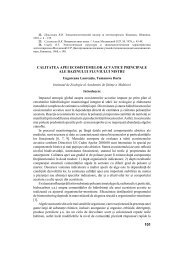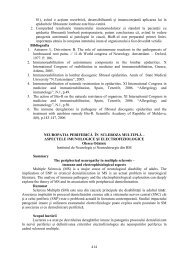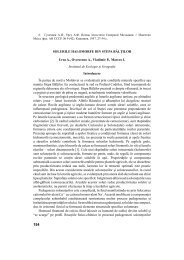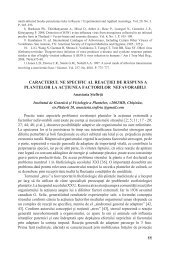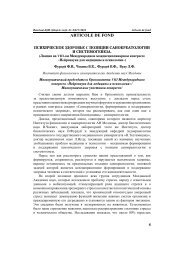BULETINUL ИЗВЕСТИЯ JOURNAL
BULETINUL ИЗВЕСТИЯ JOURNAL
BULETINUL ИЗВЕСТИЯ JOURNAL
You also want an ePaper? Increase the reach of your titles
YUMPU automatically turns print PDFs into web optimized ePapers that Google loves.
Buletinul AŞM. Ştiinţele vieţii. Nr. 3(318) 2012<br />
Abstracts<br />
UDC: 577.2.08<br />
PRIMERS HOMOLOGOUS TO TRANSPOSON АCTIVATOR IN HIGHLIGHTING<br />
OF THE PLANT MOLECULAR POLYMORPHISM. Pasha Lilia. // Buletinul Academiei<br />
de Ştiinţe a Moldovei. Ştiinţele vieţii. 2012, No 3 (318), p. 112-117.<br />
A possibility of using single PCR primers, homological to transposable element Аctivator<br />
of Zea mays in molecular polymorphism detection of Asparagus offi cinalis L., Allium cepa L.,<br />
Magnolia sp., Buxus sempervirens L., Anethum graveolens L. genomes has been studied.<br />
11 references, 5 fi gures.<br />
Key words: transposable element – Аctivator - molecular polymorphism - Asparagus<br />
offi cinalis L. - Allium cepa L. - Magnolia sp. - Buxus sempervirens L. - Anethum<br />
graveolens L.<br />
Received October 22, 2012<br />
UDC: 577.21:004.78.<br />
EXPLORATORY ANALYSIS OF GENE EXPRESSION INVOLVED IN FLOWER<br />
MORPHOGENESIS. Duca Maria, Levitchi Alexei, Martea Rodica. // Buletinul Academiei de<br />
Ştiinţe a Moldovei. Ştiinţele vieţii. 2012, No 3 (318), p. 117-125.<br />
A study based on microarray profi les of the gene expression involved in fl ower morphogenesis<br />
in plants allowed the identifi cation and analysis of direct/indirect control targets of the processes<br />
implicated in fl ower formation. There were identifi ed 44 candidate genes which modify their<br />
expression under the control of ABC system of fl ower development. All of them participate in<br />
six different processes of fl ower morphogenesis. Of them, eight genes are of the highest interest<br />
for further investigations of their functions in fl ower morphogenesis.<br />
38 references, 2 tables, 1 fi gure<br />
Keywords: microarray - gene regulatory network - ABC model of fl ower development<br />
Received November 14, 2012<br />
UDC: 599.323.4:581.52 (478)<br />
ANTAGONISTIC BEHAVIOUR AND DYNAMICS OF AGGRESSIVENESS IN<br />
MUS SPICILEGUS PETENYI 1882 (RODENTIA, MURIDAE). Larion Alina, Munteanu<br />
Andrei, Nistreanu Victoria, Cemîrtan Nelli, Savin Anatol, Sîtnic Veaceslav, Caraman Natalia.<br />
// Buletinul Academiei de Ştiinţe a Moldovei. Ştiinţele vieţii.. 2012, No 3 (318), p. 126-131.<br />
Antagonistic behavior and dynamics of aggressiveness in Mus spicilegus species was<br />
studied. In ethological experiments, 189 individuals were used, 373 pair interactions between<br />
individuals from different mounds and 322 – between individuals from the same mound were<br />
performed. Antagonistic behavior is particularly characteristic of the individuals from different<br />
mounds.<br />
The highest number of attacks was registered between the individuals with strong CNS<br />
type and medium CNS type. The dynamics of aggressiveness in M. spicilegus depending on<br />
season is of high importance for individual adaptation during their vital cycle. In spring, the<br />
aggressiveness level between males and females is low. In summer, this level decreases – the<br />
olfactory contacts were more frequent. In autumn, during mound building, the aggressiveness is<br />
low between unfamiliar individuals from different mounds and is very weak between familiar<br />
individuals from the same mound. The level of aggressiveness increases signifi cantly after<br />
fi nishing the mound building, because a well differentiated hierarchic system has been already<br />
formed in one mound.<br />
8 references, 1 fi gure<br />
Key words: Mus spicilegus - antagonistic behavior - aggressiveness<br />
Received: October 11, 2012<br />
202


